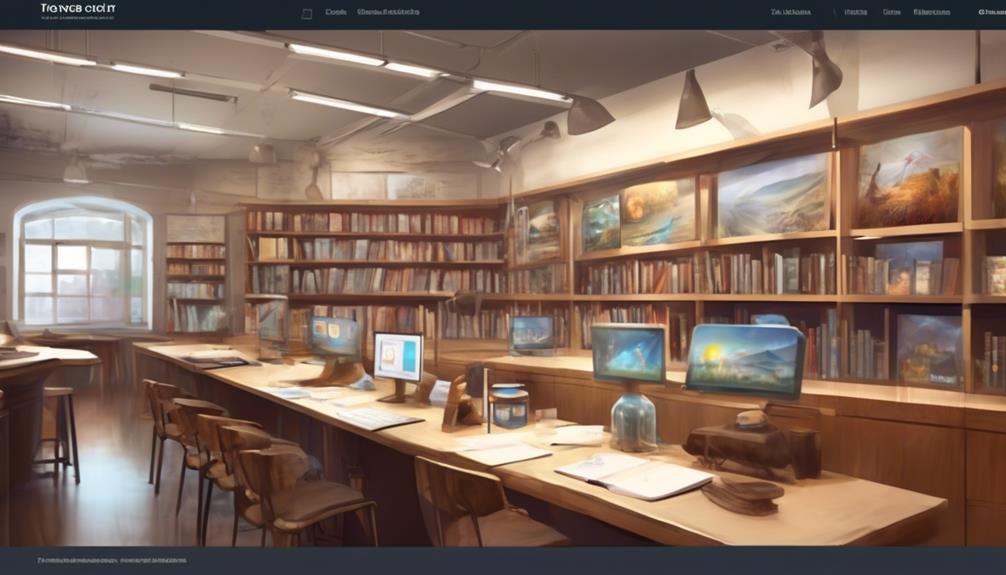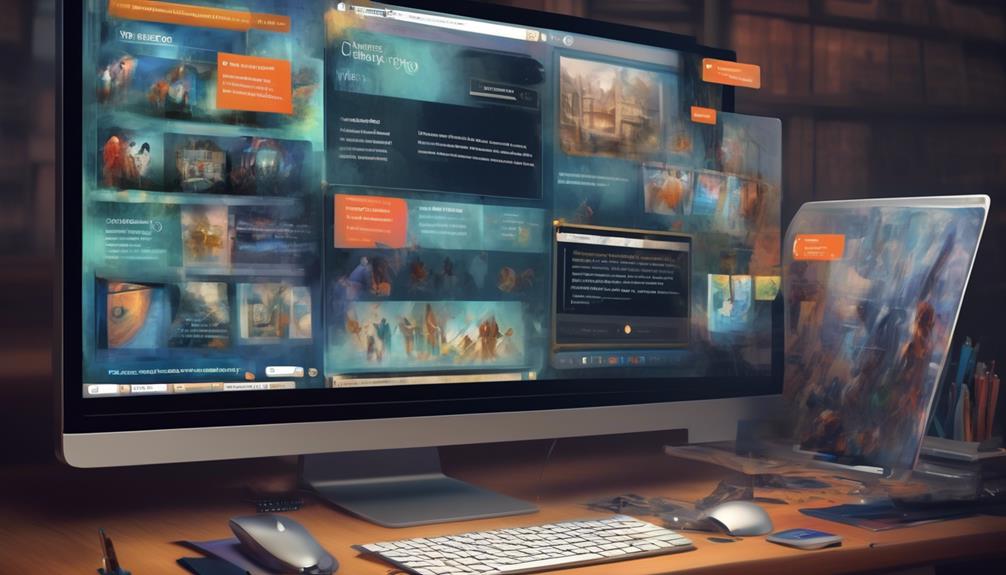We understand that improving website engagement in higher education may seem like a daunting task, especially with the myriad of other priorities institutions face. However, it's crucial to recognize the significant impact a well-engaged website can have on student recruitment, retention, and overall institutional success.
As we delve into this topic, we'll explore practical strategies and best practices that have proven successful in enhancing website engagement within the higher education landscape. By implementing these approaches, universities and colleges can effectively connect with their target audience and cultivate a thriving online community, ultimately contributing to their overall mission and objectives.
Key Takeaways
- Clear navigation, interactive content, and fast site speed are essential for website engagement in higher education.
- Personalization, user-friendly design, and visual content enhance the user experience and increase engagement.
- Search engine optimization (SEO) and mobile optimization are crucial for increasing visibility and attracting prospective students.
- Collaboration with students and effective call-to-action (CTA) strategies drive interaction and improve website engagement.
The Importance of Website Engagement

Improving website engagement is crucial for our institution as it directly impacts our ability to attract and retain prospective students and create a positive first impression. In Higher Education, students rely heavily on our website for information, making it essential that the content and website design create an engaging experience.
Clear navigation, interactive content, and fast site speed are vital for keeping visitors interested and involved. Personalization, user-friendly design, and visual content can further enhance the user experience, driving active engagement with the website.
Additionally, incorporating search engine optimization (SEO) strategies and mobile optimization is key to increasing visibility and attracting more traffic to our site. Collaboration with students and effective call-to-action (CTA) strategies are also crucial for driving interaction and engagement.
Prioritizing visual content and interactive elements can further enhance the overall website experience, creating a positive and lasting impression on prospective students, ultimately contributing to successful student recruitment efforts. By focusing on these aspects, we can effectively improve website engagement and create a compelling online presence for our institution.
Methods to Improve Engagement
We will incorporate accessibility concerns into our website management protocol to ensure compliance with standards and provide alternative text for images and proper heading structure. By doing so, we can improve engagement for both current and prospective students.
To further boost engagement, we'll simplify and enhance course searchability, offer a good user experience, provide query suggestions, and consider searchers' typos in search outcomes.
Additionally, we plan to use genuine, diverse visuals that reflect our university community, depict student interactions, and make prospective students feel more at ease. Creating attractive, informative, and engaging content, such as virtual tours, photo galleries, and blog posts about major events, will also contribute to improving website engagement.
Lastly, to ensure sustained engagement, we'll regularly update content, conduct accessibility audits, and perform user testing to guarantee website accuracy, functionality, and a positive student experience.
Enhancing User Experience

To ensure an optimal user experience, we'll incorporate accessibility concerns into our website management protocol, providing alternative text for images and captions for videos to comply with standards. By doing so, we improve the accessibility of our website, making it more inclusive for all users.
Additionally, we'll enhance course searchability by implementing a simple and swift search function, query suggestions, and consideration for searchers' typos in search outcomes. This will streamline the process for students to find the information they need, ultimately improving their user experience on our website.
Furthermore, we recognize the importance of utilizing genuine, candid visuals that accurately reflect our diverse school community and depict interactions between students and campus life. By doing so, we enhance the authenticity of our brand identity, making it more relatable to prospective students.
Moreover, we'll create attractive and informative content, such as virtual campus tours, photo galleries, and blog posts about major events, to further engage website visitors.
Regularly updating our content is also crucial to avoid bloat, maintain site optimization, and ensure accurate and relevant information for prospective students and donors. This commitment to providing up-to-date information contributes to an enhanced user experience on our website.
Utilizing Multimedia Content
Enhancing website engagement through multimedia content creates immersive and interactive experiences for our visitors. By integrating videos, infographics, and interactive elements, we improve website engagement and cater to diverse learning styles.
Virtual campus tours and showcasing student life through multimedia content provide potential students with a glimpse into university life, helping them envision themselves as part of the community. Multimedia content allows us to convey complex information in an engaging manner, meeting the website needs of our audience.
By leveraging multimedia content on our higher education website, we create an emotional connection, influencing the decision when a student chooses to attend. This approach not only enhances our university website but also enriches our social media feeds, making our content more shareable and increasing our reach.
As higher education institutions, it's crucial to recognize the impact of multimedia content in creating a compelling online presence and resonating with our audience.
Implementing Interactive Features

Utilizing popular features on social media platforms can encourage engagement and create real-time interaction with our audience. When implementing interactive features on higher ed websites, it's crucial to consider website security and data protection.
Students are most frustrated by slow-loading websites and lack of engagement. To improve website engagement, it's essential to build a website that offers a seamless and interactive experience for students. Implementing features such as live Q&A sessions, Twitter polls, and Live Stories can enhance engagement and create a dynamic online community. Collaborating with students to generate and share interactive content about the institution fosters a sense of belonging and involvement.
Clear call-to-action prompts in social media engagement posts can guide prospects to take the next step in their journey with the school. Additionally, prioritizing visual and interactive content like memes, videos, and engaging images can capture and maintain audience attention.
Success Stories and Case Studies
When incorporating success stories and case studies into our approach, we gain valuable insights into the tangible impact of interactive website engagement strategies in higher education. These real-life examples showcase specific tactics and strategies that have resulted in increased user engagement, enrollment, and other desired outcomes. They demonstrate the impact of website optimization, content creation, and user experience improvements on student recruitment and engagement.
Success stories and case studies also provide valuable insights into the challenges and solutions encountered by higher education institutions in improving website engagement. Reading these stories can inspire and inform website optimization efforts at universities.
Some examples of the insights gained from success stories and case studies include:
- Seeing how a well-designed website and improved security measures led to a significant decrease in student frustration.
- Learning about the implementation of automation tools for personalized communication with prospective students, resulting in a notable increase in applications.
- Discovering the impact of revamped landing pages on boosting student engagement and retention.
- Exploring how a university's website security for higher education websites enhanced trust and credibility among potential applicants.
- Understanding the positive outcomes of implementing interactive features on the website to improve user experience and learning.
Frequently Asked Questions
What Is Student Engagement in Higher Education?
We believe student engagement in higher education refers to students' active involvement in their learning and campus experience. It includes academic participation, involvement in student organizations, campus events, and interactions with faculty and peers.
How Do You Engage Students on Social Media?
We engage students on social media by aligning our strategy with their interests, creating interactive content like videos and memes, using features like polls and Q&As, collaborating with students, and incorporating clear call-to-action in our posts.
How Do I Engage Users on My Website?
How do we engage users on our website? We prioritize accessibility, streamline course search, use inclusive visuals, create interactive content, and regularly update information. These efforts ensure a user-friendly and engaging experience that reflects our diverse school community.
How Do You Engage Students on Campus?
We engage students on campus by creating diverse, interactive content that showcases our community and campus life. We provide virtual tours, photo galleries, and blog posts about campus events to keep students informed and engaged.
Conclusion
In conclusion, improving website engagement in higher education is crucial for attracting and engaging prospective students.
By focusing on accessibility, searchability, inclusive visuals, engaging content, and regular updates, we can create a vibrant and interactive online experience.
It's like planting a garden of diverse and colorful flowers, each one drawing in visitors and creating a captivating and welcoming environment for all who explore our digital campus.
Let's continue to cultivate an engaging online presence for our higher education community.
